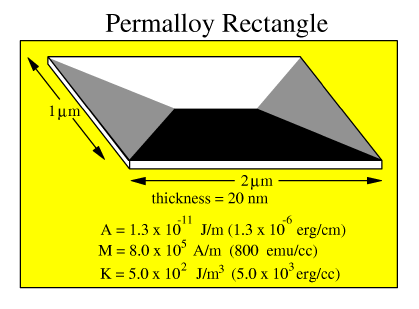muMag Standard Problem #1, Problem Statement

Specifications
- Geometry:
- 1 x 2 micron rectangle
- 20 nm (200 A) thick
- Material parameters:
- To mimic permalloy
- A = 1.3e-11 J/m (1.3e-6 erg/cm)
- M = 8.0e5 A/m (800 emu/cc)
- K = 5.0e2 J/m^3 (5.0e3 erg/cc)
- Uniaxial, with easy axis nominally parallel to the long edges
of the rectangle.
- Desired output for comparison:
- M vs. H loops, low field susceptibility
- Field approx. parallel to long axis
- Field approx. parallel to short axis
- Structural details
- Number of vortices/ cross tie walls
- How do initial conditions affect the H=0 structure?
- edge wall curling & jumps
- Approx calculation time and computer type used.
- Computational methods:
- 2-D vs. 3-D models, especially at vortices
- FFT, multipole calculations of magnetostatic fields
- Other techniques?
In this description, phrases such as "nominally parallel" and "approx.
parallel" are used to describe alignment of fields, anisotropy axes
and sample edges. Because the domain structure can vary significantly
as alignments change by as little as a degree or less, the
micromagnetic modeling results will only be experimentally verifiable
if misalignments are taken into account.
Submission guidelines are available
describing the specific calculations and output file formats we are
inviting you to contribute for direct comparison. These guidelines
include instructions on obtaining a unique submission code that will
be used to help protect the anonymity of the solutions. Your results
will then be included with the rest of our online
submission reports.
Site Directory
muMAG organization / NIST CTCMS /
[email protected]
30-May-1996
